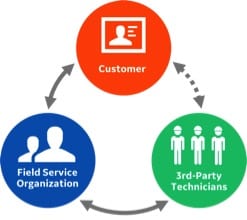A few years ago I prepared to move from my home country to the U.S. Some important things I took care of before officially relocating: finding a place to live, shipping my furniture, buying a car. Although complex tasks, they were quickly crossed off my to-do list. But once I arrived in San Francisco, I found it surprisingly difficult to choose an Internet service provider (ISP) and to schedule an installation date.
For the day of the installation, I took time off from work to accommodate the wide appointment window. Not only did the technician show up way after the window had closed, but he was also not aware of any of the specifics I had shared with the call center agent, which I had been assured would be added to the technician’s work order. When I asked him why he was missing critical information, and why he did not get in touch with me to let me know he would be late, he just shrugged. Eventually he told me that he was employed not by the ISP, but worked for a subcontractor, and that not all information was shared with him. Suffice to say, I did not feel the love — not from the technician, and certainly not from my newly chosen Internet provider.
Looking at this scenario through the lens of a field service professional, we have three parties who are involved.
 Customers don’t particularly care if it’s the service organization or a contracted partner delivering the product. What does matter to them is that technicians are on time, have all the parts and information needed to complete the job, and know what they are doing. And of course, customers expect a professional, polite demeanor from the technician. In short, it is the customer experience that counts for them.
Customers don’t particularly care if it’s the service organization or a contracted partner delivering the product. What does matter to them is that technicians are on time, have all the parts and information needed to complete the job, and know what they are doing. And of course, customers expect a professional, polite demeanor from the technician. In short, it is the customer experience that counts for them.
Now, putting myself into the shoes of the contractors, they are the ones delivering the service to customers on behalf of other companies. To be successful, and adhere to contractually determined service level agreements, contracted partners need to be empowered to do their job — to the satisfaction of both the customer and the service organization. And that means not only giving them the right information and tools but also to make it easy for them: easy to get to the information they need, easy to follow any service-related process, and easy to communicate with customers, each other, and the service organization who assigns them the work orders.
Don’t miss our upcoming webinar: Managing Third Party Contractors (May 10)
So, for customers it is all about their experience, for contracted partners it is about the ease-of-use and enablement to achieve agreed-upon goals. What is important for service organizations as the main stakeholders? Customer experience and visibility into operations.
Customer Experience
Customers are the No. 1 priority for field service organizations, and customer experience is their measure for success. Consequently, even when outsourcing field work to third-party technicians, service organizations need to continue to own the customer relationship and to control the experience.
Visibility into Partners’ Operations
Putting the customer first requires service organizations to keep tight reins on their partners’ performance. Something they can only achieve by having real-time visibility into each step of the outsourced field service delivery process — from assigning work orders to contractors, to issuing invoices to customers.
Field service companies have different reasons for working with contractors. They vary from wanting to increase their geographical coverage, to meet seasonal demand, or for specific types of work. Or they are outsourcing all field service activities to third-party technicians. Regardless of their motivation, to “let customers feel the love”, field service organizations need to find the means to address both the needs of the contractors and their own field operations.
Register for our upcoming webinar, “Managing Third Party Contractors,” on May 10.


Share this: